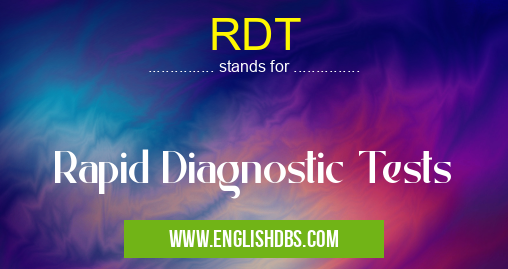What does RDT mean in MEDICAL PHYSICS
Introduction:

RDT meaning in Medical Physics in Medical
RDT mostly used in an acronym Medical Physics in Category Medical that means Rapid Diagnostic Tests
Shorthand: RDT,
Full Form: Rapid Diagnostic Tests
For more information of "Rapid Diagnostic Tests", see the section below.
Rapid Diagnostic Tests (RDTs)
Rapid Diagnostic Tests (RDTs) are medical tests designed to provide quick and accurate results for the diagnosis of a specific disease or condition. These tests are typically simple to perform and can be used in various settings, including point-of-care, field, and laboratory environments. RDTs play a vital role in early detection, treatment, and surveillance of diseases, enabling timely interventions and improved patient outcomes.
Mechanism:
RDTs rely on the principle of antigen-antibody reactions or nucleic acid amplification for detection. In the case of antigen-antibody RDTs, antibodies specific to the target pathogen are immobilized on a solid support, such as a lateral flow strip or dipstick. When the sample containing the pathogen is applied, the antibodies bind to the pathogen, and a visible reaction occurs, indicating a positive test result. In molecular RDTs, nucleic acid amplification techniques, such as PCR or LAMP, are used to detect the presence of the pathogen's genetic material.
Advantages:
- Rapid results: RDTs provide results within minutes to hours, facilitating prompt treatment and intervention.
- Simplicity: These tests are designed to be easy to perform, allowing for use in non-laboratory settings.
- Cost-effectiveness: RDTs are generally cost-effective, enabling widespread access to testing.
- Portability: Many RDTs are portable and can be used in resource-limited settings.
Applications:
RDTs have a wide range of applications in diagnosing and managing infectious diseases, including:
- HIV: HIV RDTs are used to diagnose HIV infection and monitor viral load.
- Malaria: Malaria RDTs detect the presence of malaria parasites in blood samples.
- Influenza: Influenza RDTs identify influenza viruses for early diagnosis and appropriate treatment.
- Dengue: Dengue RDTs can diagnose dengue fever and differentiate it from other febrile illnesses.
- Cholera: Cholera RDTs detect cholera-causing bacteria in stool samples.
Conclusion:
Rapid Diagnostic Tests (RDTs) are valuable tools for diagnosing and managing diseases in a timely and accurate manner. Their simplicity, cost-effectiveness, and portability make them particularly useful in resource-limited settings where access to traditional laboratory testing may be limited. RDTs empower healthcare professionals to make informed decisions and initiate appropriate interventions, leading to improved patient outcomes and disease control.
Essential Questions and Answers on Rapid Diagnostic Tests in "MEDICAL»MEDPHY"
What are Rapid Diagnostic Tests (RDTs)?
RDTs are quick and easy-to-use medical tests that provide results within minutes or hours, unlike traditional laboratory tests that can take days or weeks. RDTs are designed to identify specific microorganisms, such as bacteria or viruses, or to detect certain substances in a sample, such as antibodies or antigens.
How do RDTs work?
RDTs rely on the principle of antigen-antibody reaction. When a sample containing the target antigen or antibody is added to the test device, it reacts with specific antibodies or antigens immobilized on the test strip. This reaction generates a visible signal, such as a colored line or dot, indicating the presence or absence of the target analyte.
What are the advantages of using RDTs?
RDTs offer several advantages, including:
- Rapid results: RDTs provide results within minutes or hours, allowing for timely diagnosis and treatment.
- Ease of use: RDTs are typically simple to perform, requiring minimal equipment and technical expertise.
- Point-of-care testing: RDTs can be performed at the point of care, such as in clinics, hospitals, or even at home, making testing accessible and convenient.
- Low cost: RDTs are generally low-cost, making them affordable for use in resource-limited settings.
What are the limitations of RDTs?
RDTs have some limitations, such as:
- Sensitivity and specificity: RDTs may not be as sensitive or specific as traditional laboratory tests, which means they may produce false-positive or false-negative results.
- Interpretation: RDT results can sometimes be difficult to interpret, especially in cases where the signal is weak or ambiguous.
- Quality control: Ensure the accuracy and reliability of RDTs is essential.
In what settings are RDTs commonly used?
RDTs are widely used in various settings, including:
- Clinical diagnostics: RDTs are used to diagnose infectious diseases, such as malaria, HIV, and influenza.
- Environmental monitoring: RDTs can detect environmental contaminants, such as pesticides or heavy metals, in water or soil samples.
- Food safety: RDTs can be used to detect foodborne pathogens, such as Salmonella or E. coli, in food products.
- Veterinary medicine: RDTs are employed to diagnose animal diseases, such as avian influenza or bovine leukemia virus.
RDT also stands for: |
|
| All stands for RDT |
